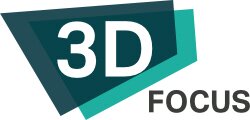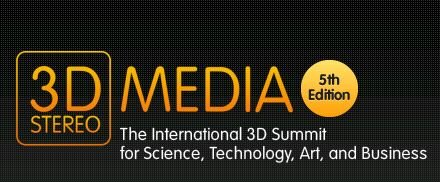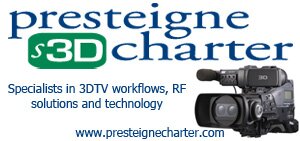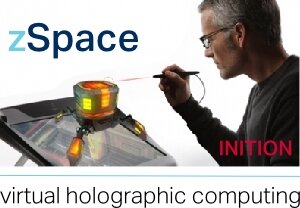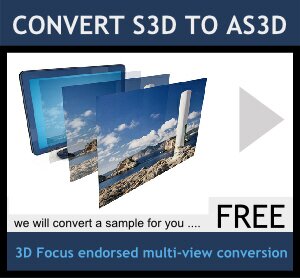In this guest interview, Torsten Hoffman, CEO of 3D Content Hub, interviews holographic artist Ikuo Nakamura from Hololab, on behalf of 3D Focus.

Torsten Hoffman: Can you please briefly introduce yourself and tell us about your experience in 3D?
Ikuo Nakamura: I have been working with spatial imaging projection, especially holography since the early 80's. I learned holography at the Physics department at the Tokyo University of Science, and then at New York Holographic Laboratory where pioneer Holography artists, Dan Schweitzer and Sam Moree operated.
I started my Hololab Studio near Times Square in Manhattan and I created my holographic works there. In 1998 I was invited and stayed for a year as fellow artist at the Academy of Media Art, Cologne, Germany. In 2004, I joined the Centre for the Holographic Arts as co-director. We supported artists from all over the world who wanted to create holograms.
At the Holocenter, we can shoot portraits or live objects with a Ruby Pulse Laser. I also worked for Rayvel as Chief Research Scientist and contributed to a patent there. My stereoscopic 3D experience was always part of my holography career. I would take stereo paired slides of my holograms and send them to curators with a stereo slide viewer. Photographing holograms in 2D is not a good enough true representation.
3D photography was always a good friend to me and there is a strong connection between holography and stereo 3D. It is Holographic Stereogram. I used to shoot holograms of solid objects with lasers on vibration isolated optical tables. In the early 90's I built a holographic stereogram camera, which enabled me to leave the dark basement studio. This synthetic holography opened a new horizon. I shot horizontal parallax image sequences on rail and integrated stereoscopic images, and digitally processed them and combined the result with rendered CG images. I could print those out as a holographic stereogram. These image sequence materials are exact moving stereo-paired 3D images. It was very natural how, as a holographer, I started in stereo 3D video.
Torsten Hoffman: Tell us more about your work at Hololab. What installations have you done and how is it connected to 3D? Where can we see your exhibits?
Ikuo Nakamura: I have worked on various types of holographic installations including a unique experimental interactive installation "Neuro Holography" (Video can be seen here)
It was a brain-wave interactive installation, whereby viewers' EEG signals controlled the lighting system which illuminates the multi layered holographic stereogram. Integrated 3DCG sequences were composed on holographic film. This interactive holographic animation system is an artistic metaphor of neuro-physician Karl Pribram's thesis "The Brain as Hologram." This was exclusively exhibited at Holographic Network in Berlin, Germany.
"Thera" (video here) was a combination of a ruby pulsed portrait Hologram with a time-shifted digital projection; a model posed as the painting "Madam X" by John Singer Sargent. His original painting was scandalous and banned in Paris at the time and Singer had to hide it and repaint some parts. Our hologram image shows the banned original pose, while the digital projection over the hologram sways to the repainted pose. This installation was exhibited at various galleries and museums in the US including MIT museum's Luminous Windows Exhibit in Cambridge MA.
Our most recent show was a special exhibit of Harry Houdini, the famous escape artist and magician. This exhibition travelled from New York to Los Angeles, San Francisco and Madison in the USA. I titled the installation "Materialization"; in it Houdini's chain locked holographic arms are stretching out from a real milk-can. This installation merges real space with holographic dimension.
Most of my holograms are presented with space consciousness. Holography is naturally 3D media, and since I started, I have been asking myself that "Why must this piece be done with holography?", "Why do I need 3D representation?", "Why not paint, take photographs or sculpture it?" I think today stereographers and 3D filmmakers who shoot narrative stories may ask the same kind of questions.
But even I have few chances to show my holography works in public, those are only in museums, galleries or special exhibitions. I have been frustrated by this situation for a decade. But the recent growth in 3DTV and 3D movie theatres has excited me. What if an independent 3D artist can make 3D films as an art form? It can be achieved with relatively low production budgets.
Torsten Hoffman: You are one of the contributors of the "Best of 3D" compilation. Your short film received rave reviews. Tell us about your content.
Ikuo Nakamura: Yes, I am very glad that my very first time lapse 3D series from Easter Island is included on this 3D Blu-ray. I stayed on this most isolated island for 5 weeks last year and compiled a series of footage covering this unique island's landscape with mysterious huge stone statues "Moai". The light is very bright, the sky seems higher while the clouds are almost touching the ground there.
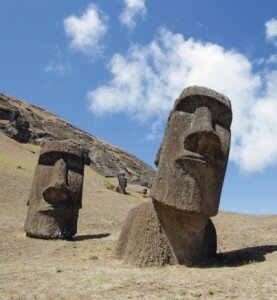
Fortunately, there is no light pollution from the South American coast (3600km away) at night. So the Milky Way is always visible when there is no moon. I positioned 2 cameras with a wider interocular setting for mid-range distance where statues stand behind a landscape or with the sky as background. It is purposely not designed to replicate regular human perception; as this setup results in a feeling as if you are a very tall ‘giant’. Thanks to this effect, it is amazing to see how cloud formations change in 3D.
Large part of sequences are time lapsed images. I decided to use this method to capture this mysterious island where time passes differently than in our world. It's a non-narrated 3D film of about 6 minutes in duration. It's short, but you re-discover this Island. I looked over South pacific from volcanic shore at night, and noticed there is no sign of land at all, then I suddenly realized that the only land the isolated islanders saw was the Moon.
Torsten Hoffman: What equipment did you use to create these time-scapes?
Ikuo Nakamura: The time lapse sequences were shot with DSLR Canon 7D, 5D or SONY NEX-5 cameras. A custom-designed stepper motor driven rail system was used for time lapsed dolly effect. The benefit of using DSLR cameras is you get a higher resolution than the 4K format. I encoded 1080p for 3D Blu-ray and it can even be upgraded to 4K resolution upon request. The gears’ weight was also important as I cannot carry a pair of fully equipped RED cameras and heavy rail system to these locations.
For time-lapse shooting, picking Canon's full format DSLRs or recent light weight mirror-less DSLRs was an obvious choice to me. I stripped the intervalometer's cable to connect to both Canon DSLRs to sync.
For the SONY NEX-5, since this camera does not have external shutter contact, I built an infrared trigger system to control both cameras. There is a way to hack the NEX-5. We used After Effect and Premiere Pro, and Vegas Pro along with CineForm codec in post-production
Torsten Hoffman: We noticed the stunning footage in the dark, with the starry sky/the Milky Way, circling above the famous statues. How did you manage to get the exposure right?
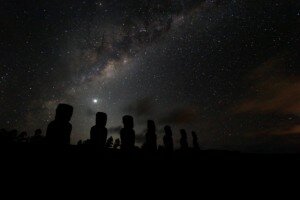
Ikuo Nakamura: The sky rotates 360 degrees in 24 hours and the exposure time must be less than 30 seconds. After more than 30 seconds, the stars start to trace lines making the Milky Way cloudy even with very wide lenses. I prefer 20 seconds to get a sharper image, but then the ISO should not be very high; a pixel of a dim star and sensor noises looks similar if you push to ISO6400. I chose 30 seconds in ISO1600 with ultra wide lens with F4 and then pushed the exposure up a bit in post process.
I tested many combinations to find the sweet spot. Most difficult parts were focusing and flaming. Focusing has to be done before dark, I taped focusing ring to fix. The light from the Moon helps me to confirm the focus and frame, but it also prevents the best Milky Way shots.
I had to be extremely patient to see stars and shadow of statue in camera's finder with a well adjusted eye in the dark. As I mentioned, the low light pollution also helped. I set the interocular distance to more than 60 cm wide and both cameras were mounted independently; It was extremely difficult to align 2 cameras in the dark. And after all that preparation, such a basic mistake like mismatching the camera's exposure time or F-stop caused disaster, ruining a whole night’s shooting which happened a couple of times. But I am glad that the final film turned out well and is popular with the viewers.
Ikuo Nakamura’s stunning sequence is included on the Best of 3D Blu-ray available from . For more information about 3D content distributor 3D Content Hub click here and to discover more about Ikuo's work visit the Hololab site and the Vimeo page.
FREE WEEKLY 3D NEWS BULLETIN –





